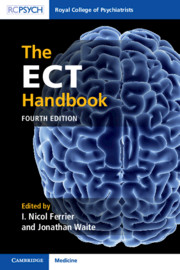Book contents
- The ECT Handbook
- The ECT Handbook
- Copyright page
- Contents
- Contributors
- Preface
- Chapter 1 The Place of ECT and Related Treatments in Contemporary UK Psychiatry
- Chapter 2 Mechanism of Action of ECT
- Chapter 3 ECT in the Treatment of Depression
- Chapter 4 ECT in Mania (and Mixed States)
- Chapter 5 Electroconvulsive Therapy in Bipolar Disorder Depression
- Chapter 6 ECT in Older Adults
- Chapter 7 ECT in People with an Intellectual Disability
- Chapter 8 ECT in Pregnancy and Postnatally
- Chapter 9 Electroconvulsive Therapy in Children and Adolescents
- Chapter 10 The Use of ECT in the Treatment of Schizophrenia
- Chapter 11 The Use of ECT in the Treatment of Catatonia
- Chapter 12 ECT in Neuropsychiatric Disorders
- Chapter 13 Cognitive Side-Effects of ECT
- Chapter 14 Non-cognitive Adverse Effects of ECT
- Chapter 15 Transcranial Magnetic Stimulation
- Chapter 16 Neurosurgery for Mental Disorder
- Chapter 17 Ketamine for Psychiatric Disorders
- Chapter 18 The ECT Accreditation Service (ECTAS)
- Chapter 19 The Scottish ECT Accreditation Network (SEAN)
- Chapter 20 Medical Training for Psychiatrists in ECT
- Chapter 21 Nursing Care of the Patient Receiving ECT and the Roles of the ECT Nurse
- Chapter 22 Practical Aspects of ECT
- Chapter 23 Anaesthesia for Electroconvulsive Therapy
- Chapter 24 Dental Issues Related to ECT
- Chapter 25 Interactions between ECT and Prescribed Medication
- Chapter 26 Seizure Monitoring in ECT
- Chapter 27 Safe ECT Practice in People with a Physical Illness
- Chapter 28 Capacity, Consent and the Law
- Chapter 29 Patients’, Carers’ and the Public’s Perspectives on ECT and Related Treatments
- Index
- References
Chapter 1 - The Place of ECT and Related Treatments in Contemporary UK Psychiatry
Published online by Cambridge University Press: 27 June 2019
- The ECT Handbook
- The ECT Handbook
- Copyright page
- Contents
- Contributors
- Preface
- Chapter 1 The Place of ECT and Related Treatments in Contemporary UK Psychiatry
- Chapter 2 Mechanism of Action of ECT
- Chapter 3 ECT in the Treatment of Depression
- Chapter 4 ECT in Mania (and Mixed States)
- Chapter 5 Electroconvulsive Therapy in Bipolar Disorder Depression
- Chapter 6 ECT in Older Adults
- Chapter 7 ECT in People with an Intellectual Disability
- Chapter 8 ECT in Pregnancy and Postnatally
- Chapter 9 Electroconvulsive Therapy in Children and Adolescents
- Chapter 10 The Use of ECT in the Treatment of Schizophrenia
- Chapter 11 The Use of ECT in the Treatment of Catatonia
- Chapter 12 ECT in Neuropsychiatric Disorders
- Chapter 13 Cognitive Side-Effects of ECT
- Chapter 14 Non-cognitive Adverse Effects of ECT
- Chapter 15 Transcranial Magnetic Stimulation
- Chapter 16 Neurosurgery for Mental Disorder
- Chapter 17 Ketamine for Psychiatric Disorders
- Chapter 18 The ECT Accreditation Service (ECTAS)
- Chapter 19 The Scottish ECT Accreditation Network (SEAN)
- Chapter 20 Medical Training for Psychiatrists in ECT
- Chapter 21 Nursing Care of the Patient Receiving ECT and the Roles of the ECT Nurse
- Chapter 22 Practical Aspects of ECT
- Chapter 23 Anaesthesia for Electroconvulsive Therapy
- Chapter 24 Dental Issues Related to ECT
- Chapter 25 Interactions between ECT and Prescribed Medication
- Chapter 26 Seizure Monitoring in ECT
- Chapter 27 Safe ECT Practice in People with a Physical Illness
- Chapter 28 Capacity, Consent and the Law
- Chapter 29 Patients’, Carers’ and the Public’s Perspectives on ECT and Related Treatments
- Index
- References
Summary
The previous edition of The ECT Handbook was produced in 2013 and was well received. The current edition updates the 2013 one and attempts to find a similar balance between outlining the scientific literature relating to ECT and related treatment modalities and pragmatic and practical advice on their place in management and delivery in a UK context. This chapter concentrates on the guidelines in the UK for the use of ECT and related treatments. The recommendations of NICE for the use of ECT and related treatments are outlined first, followed by position statements from the Committee. Any differences (which are usually minor and of emphasis rather than substance) are highlighted. The position statements were generated in 2017 and have been ratified by the College. They can be found on the Royal College of Psychiatrists’
- Type
- Chapter
- Information
- The ECT Handbook , pp. 1 - 12Publisher: Cambridge University PressPrint publication year: 2019



